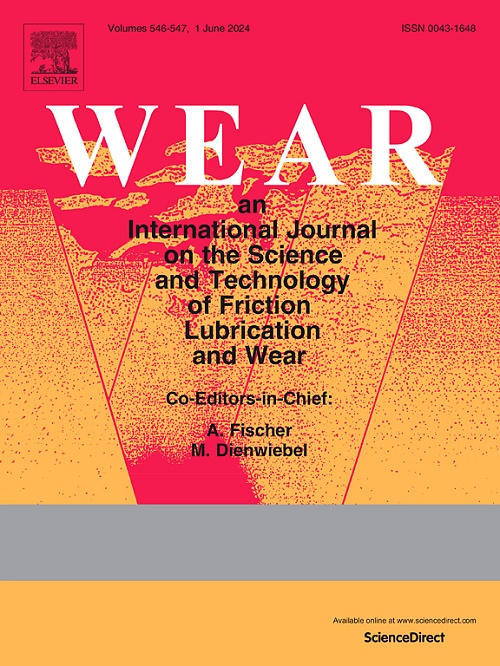Effect of copper-rich precipitations on the adaptive behavior of low carbon martensitic steels during dry sliding wear
IF 5.3
1区 工程技术
Q1 ENGINEERING, MECHANICAL
引用次数: 0
Abstract
The adaptive behavior of martensitic steel during sliding wear, such as tribo-oxidation layer (ToL) formed in situ on the wear surface and the plastic deformation layer (PDL) formed spontaneously on the subsurface layer, can effectively inhibit wear. In this paper, the dry sliding wear behavior of 15-5 PH martensitic stainless steel after solution treatment and aging treatments was analyzed, and the influence mechanism of copper-rich precipitations (CPRs) on the adaptive behavior during wear process was explored by molecular dynamics simulation. The results show that the average wear loss of 15-5 PH steel aged at 450 is about 89.7 % lower than that solution quenching at 1050 under the action of nanoscale copper-rich precipitations (Nano-CPRs). The Nano-CPRs effectively hinder the slip of dislocations, which not only enhances the deformation resistance of the material, but also promotes the formation of more uniform subgrain boundaries in the subsurface. A large number of sub-grain boundaries enhance the overall performance of the PDL that effectively prevent the failure and serious wear of the ToL. This work reveals the failure mechanism of the ToL, the formation mechanism of the PDL and the influence mechanism of the CPRs on friction adaptive behavior of 15-5 PH steel, and also provides theoretical support for optimizing the wear resistance of martensitic steel.
富铜沉淀对低碳马氏体钢干滑动磨损自适应行为的影响
马氏体钢在滑动磨损过程中的自适应行为,如磨损表面原位形成的摩擦氧化层(ToL)和亚表面层上自发形成的塑性变形层(PDL),可以有效地抑制磨损。本文分析了15-5 PH马氏体不锈钢经固溶处理和时效处理后的干滑动磨损行为,并通过分子动力学模拟探讨了富铜沉淀(CPRs)对磨损过程中自适应行为的影响机理。结果表明:在纳米级富铜析出物(Nano-CPRs)的作用下,450℃时效的15-5 PH钢的平均磨损损失比1050℃固溶淬火的平均磨损损失低89.7%;纳米cprs有效地抑制了位错滑移,不仅提高了材料的抗变形能力,而且促进了亚表面形成更均匀的亚晶界。大量的亚晶界提高了PDL的整体性能,有效地防止了ToL的失效和严重磨损。揭示了ToL的失效机理、PDL的形成机理以及CPRs对15-5 PH钢摩擦自适应行为的影响机理,为优化马氏体钢的耐磨性提供了理论支持。
本文章由计算机程序翻译,如有差异,请以英文原文为准。
求助全文
约1分钟内获得全文
求助全文
来源期刊

Wear
工程技术-材料科学:综合
CiteScore
8.80
自引率
8.00%
发文量
280
审稿时长
47 days
期刊介绍:
Wear journal is dedicated to the advancement of basic and applied knowledge concerning the nature of wear of materials. Broadly, topics of interest range from development of fundamental understanding of the mechanisms of wear to innovative solutions to practical engineering problems. Authors of experimental studies are expected to comment on the repeatability of the data, and whenever possible, conduct multiple measurements under similar testing conditions. Further, Wear embraces the highest standards of professional ethics, and the detection of matching content, either in written or graphical form, from other publications by the current authors or by others, may result in rejection.
 求助内容:
求助内容: 应助结果提醒方式:
应助结果提醒方式:


